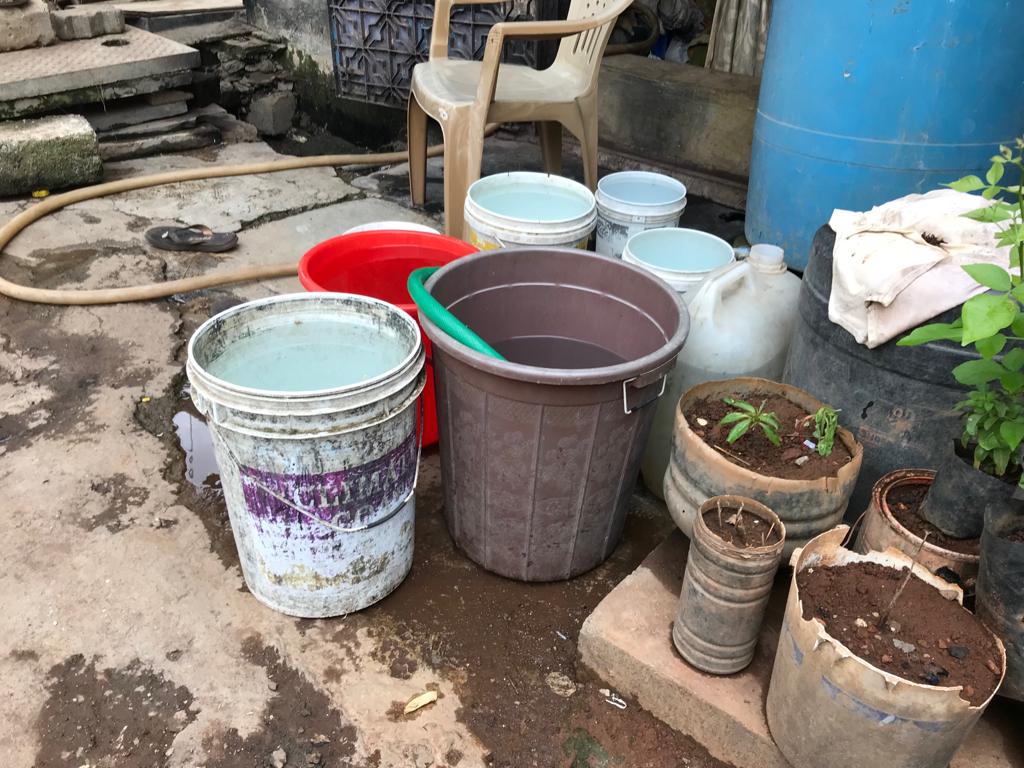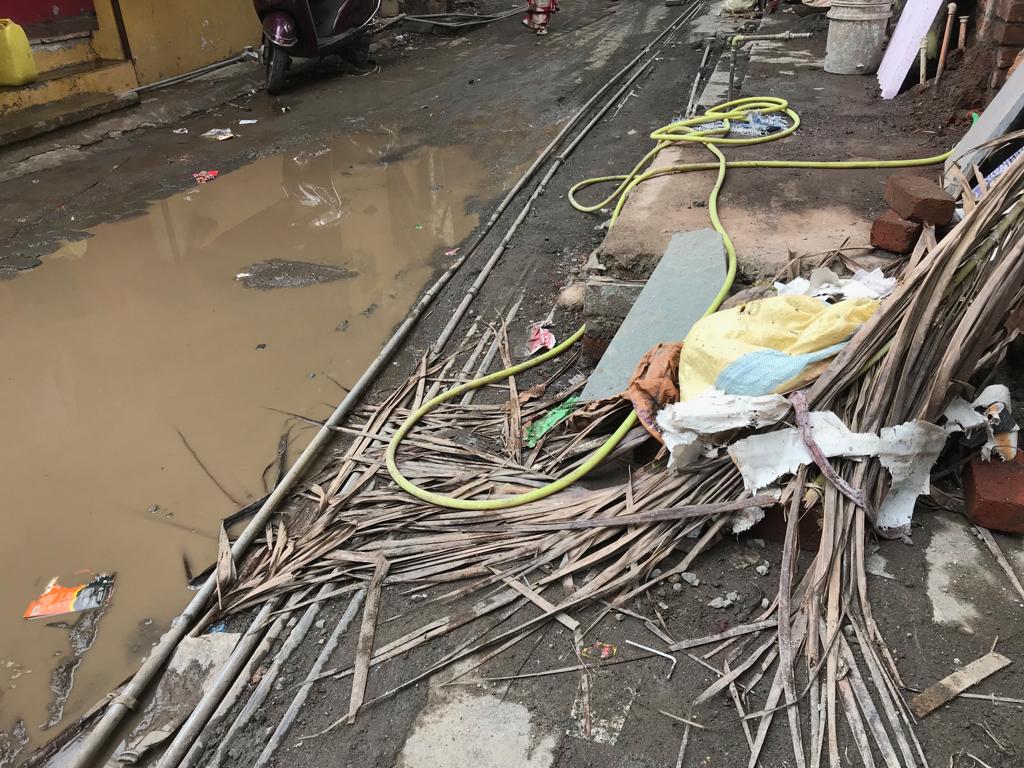
Take the case of Mumbai’s eastern suburbs. Areas such as Govandi, Mahul, Mankhurd, right up to Vashi Naka are reeling under severe water cuts. Mumtaz Sheikh, program manager (Women Empowerment) for Committee of Resource Organisation (CORO) who has been working with underprivileged women in the area says, “A majority of the people living in Rafiq Nagar, Shivaji Nagar and slums near Vashi Naka belong to low income Dalit and Muslim families. In most neighbourhoods, it is virtually impossible to get a legal water connection and there is a water mafiathat operates with impunity taking advantage of hapless families forcing them to shell out nearly Rs 100/- every day.” Wherever, there are a few legal water connections, the drinking water pipelines often pass through nullahs. “So, if there is a leakage, which happens quite often due to corrosion and wear and tear, the drain water gets mixed with the drinking water making it unfit for consumption,” says Shaikh.
Shaikh also highlights the disparity between water supply to wealthier neighbourhoods and economically backward ones saying, “Wealthier neighbourhoods, be they residential complexes and business establishments get water 24 hours, but people in the slums have to struggle with whatever they can get and store in precisely 30 minutes every day!” As fetching water is seen predominantly as a woman’s burden, many girls drop out of school just so they can fetch enough water to keep their families alive. Moreover, it appears that the civic administration has failed to take into account the population growth in the area due to rehabilitation projects. The existing infrastructure is stretched thin.
Low income neighbourhoods in Mumbai’s northern suburbs are also suffering. Sajid Pathan, a resident of Malwani says, “It is true that impoverished neighbourhoods are worse affected than others. Though, residents get water for three hours every day, the problem is two-fold. First, for every three families that have legal water connections with proper meters, there are two families that don’t, and have to depend on water from illegal sources. Secondly, the quality of water supplied by the municipality is filthy! It is dark and unfit for drinking or even washing.” According to Pathan, while people from all communities live in Malwani, a majority are Muslims.
But the residents had an uphill task even after the protest. “Following our protest the municipal corporation was forced to make necessary repairs. But during that period, almost the entire month of April, we had no water and were forced to buy water from the local black market water dealers,” says Tejal. “We shelled out Rs 25 per can of water. One can contains 20 liters and each family needed at least 7-8 cans,” explains Shahida. “Even today, though we get water for 3 hours every day, the first 15 minutes sometimes even the first 45 minutes, the water is dirty,” says Ms Patel. “Also, the timings have been changed. Earlier, we used to get water at 6AM so we could finish storing it early, but now it comes at 10AM and this is inconvenient for working women,” says Tejal.

Nadeem Ansari, a local shop keeper says, “When the women took out the protest march demanding justice for our sick children, it also made the local police take notice. They were very cooperative and encouraged us to take our grievances to the local municipal officials. Within eight days the officials began repair work.”
Ameena Nafees, an elderly resident says, “Now the water supply is sufficient and the quality has improved. But we still have a problem with proper garbage disposal and water logging which will pose a challenge during heavy rains.”
The Municipal Corporation of Greater Mumbai (MCGM) recognizes that many people are forced to live in slums and has made special provisions for such neighbourhoods. According to the MCGM, “It is our commitment to provide access to water to all the citizens of Mumbai and we recognize that a large part of our community is living in the informal settlements. Water services are provided to these informal settlements in the form of a common connection in General Washing Place (GWP) for a group of minimum 5 households. The citizens in slums having proof of existence prior to 01.01.2000 are eligible for water connection as per present policy.”
The situation in Thane
Just north of Mumbai, in adjacent Thane district the situation is not as grave as it was until a few years ago when there were 60-hour water cuts every week. Now it is down to 24-36 hours per week.
Mumbra, a suburb that is home to middle and low income families from the minority community, is faring better this year despite a cut in supply. Says, Surraiya Mohammed Husain Shaik who has been living in the Chand Nagar area for over 10 years with her husband, “Earlier we used to get water daily between 3PM and 5PM, but since early March we are facing a water cut and would get water only 2-3 times a week. However, during Ramzan, as a special courtesy the municipal corporation changed and increased the timings from 6PM to 10PM every two days. So the amount of water is sufficient, unless you have a large family.” She also tells us how builders in many chawls have also set up bore-wells to supply additional water. “The water may not be fit for drinking or cooking, but can be used for flushing and washing purposes. Each family gets about 30 minutes of bore-well water supply.”
But not everyone is comfortable with the timings. 23 year old Bushra Mahmood Ahmed who lives with her elderly parents and six year old nephew in the Shivaji Nagar area of Mumbra says, “Timings are extremely inconvenient. We get water between 11:30 PM and 2:30 AM and this was particularly troublesome when we had to do sehri at 3:30 AM during Ramzan. We hardly slept a wink!” She also highlights how privileged neighbourhoods have more convenient timings. “Building people get water between 7AM and 9AM, while we chawl women have to fetch water late at night,” she says. The water they fill is just about sufficient to cook, clean, bathe and wash clothes, but there isn’t much left afterwards. “The water that I fill runs out by 2:30PM and I don’t have much left till we get more at 11:30PM,” she says.
In Thane city, the Rabodi area is home to a significant population from the minority community many of whom come from middle or low income households. However, there are also several middle income families from the majority community and all residents have been suffering due to water cuts since February. Says Kalpesh Sawardekar, a resident, “There is no water supply between 9AM on Wednesday and 9AM on Thursday. But we plan and store water in advance and manage somehow.” 45 year old mother of two Sadiya also echoes the same. “It is difficult, but not as bad as it was a few years ago. There is no supply for 24 hours, but we manage because we store water in advance. Plus I am very strict about wastage,” she says.
According to Deputy City Engineer Arjun Ahire, who heads the Water Department, water cuts across the region are uniform and no neighborhood is given preference over another. “Some neighbourhoods located near the tail end of the water lines may experience lower pressure, but we are not doing that deliberately. We don’t play favourites,” says Ahire. However, he does admit that there is a shortage of water and water cuts are likely to continue for at least one month more. “At this point, water supply is very cut-to-cut and we are often struggling to provide enough water. We have requested MIDC to provide 20-25 MLD of additional water daily,” says Ahire. “The Irrigation Department has scheduled water cuts till July 15 this year. While the estimated rainfall this year is 96 per cent, we would rather see what actually happens instead of speculating based on estimates,” he says.
The TMC sources 480 Million Liters Daily (MLD) of water for 23 lakh people from four sources:
- Bhatsa Dam (TMC’s own source) supplies 200 MLD
- Maharashtra Industrial Development Corporation supplies 110 MLD
- Municipal Corporation of Greater Mumbai (MCGM) supplies 60 MLD
- Shahad-Temghar Water Supply Authority (STEM) water distribution and infra co Pvt Ltd. Supplies 110 MLD